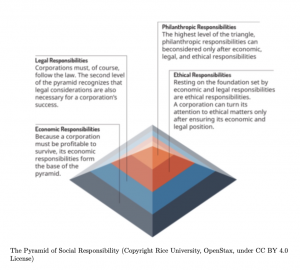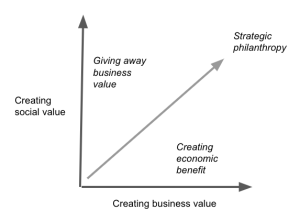Part 7: Implementation, Strategy, and Stakeholder Duties
96 What is strategic corporate philanthropy?
Remember the CSR pyramid we introduced earlier in the text. The foundation of the pyramid was the economic concerns of a company. Without the ability to turn a profit, no company can exist in the long-term. We then built on these concerns with treatment of legal and ethical duties, both of which tie into the long-term success of any company. The top of this pyramid is philanthropic responsibilities. When a company has satisfied the lower levels of the pyramid, corporate philanthropy can be a powerful tool to help advance company interests and do good in the world. In other words, corporate philanthropy can be an excellent way to build business and social value.

Michael Porter and Mark Kramer published an article in the Harvard Business Review which outlined a framework for considering strategic corporate philanthropy. Porter and Kramer suggest that much corporate philanthropy is “unfocused”, such as providing small cash grants to charities or supporting employee charitable work. While these may improve employee morale and generate goodwill, they may not provide long-term strategic value of the company. In other words, there may be a great deal of social benefit, but little economic benefit. In contrast, strategic philanthropy can build both. Consider the following diagram, which shows economic benefit on the x-axis and social benefit on the y-axis. A business engaged in pure profit seeking may generate some social value from the provision of its goods, but the primary purpose of its actions is to create economic profit for business owners. In contrast, a business engaged in untargeted philanthropy may derive some business value from generation of goodwill and advertising, but the primary benefit is to others.

In contrast, the central area of the graph illustrates that these can be combined. Strategic philanthropy may create social value while simultaneously creating business value. An editable version of this graph is here.
For example, Porter and Kramer highlight the Cisco Networking Academy, a training program for young network administrators. Youth are offered educational opportunities which may benefit them with any employer, but Cisco simultaneously trains future employees and creates recognition with them long before seeing their resumes on the job market. Or, a company operating in the tropics may invest in public heath efforts like fighting malaria, which both benefit local communities and help keep employees healthy. In our terms, the top of the CSR pyramid is supported by the bottom, but it also contributes to the bottom-line. Considering what might comprise strategic philanthropy is a challenge, but one worth serious consideration for a company with the means available to engage in philanthropic efforts.

Exercises
- For the company you have been considering in these exercises, what is an example of a strategic philanthropy project that creates business and social value? This could be either a real project or one you think the company should consider.

